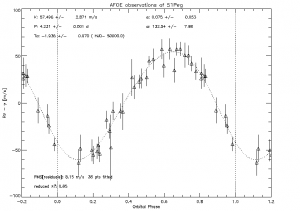Have you ever wondered how many stars there are in our universe? The number is anywhere between ten thousand trillion (1022) to one quadrillion (1024). The fraction that fall within the same classification as our sun, a G type star, is about 7.6%. Additionally, it is estimated by NASA that 1 in 6 stars will contain an Earth-Sized planet. Further, detecting Earth-sized planets hundreds of trillions of miles away is a non-trivial feat to say the least, leading to possible underestimates and uncertainty. Human curiosity of space and the intrinsic challenge of finding these seemingly hidden planets in the vastness of space has led astronomy to a new frontier.

The discovery of new exoplanets canidates by the Kepler Space Telescope as of June 2017. Source: Wikimedia commons
Astronomy is constantly reminding us that earth and our solar system is minute. While much is known about our immediate solar neighborhood, gaps in knowledge and improved technology has driven a strong surge in detection of astronomically small objects. In particular, there has been a growing interest in exoplanet detection. Exoplanets are simply planets outside of our solar system. So far, we have discovered 3926 exoplanets, with the Kepler space telescope launched in 2009 claiming 2338 with another 2423 living in limbo yet to be confirmed. While stars emitting immense amounts of light may occasionally be detected directly, exoplanet detection often relies on indirect techniques.

Artist depiction of Pegasi 51 b. Source: Wikimedia commons
The first exoplanet detection was made in 1992 by astronomer Aleksander Wolszczan orbiting around an exotic type of star called a pulsar at 2300 ± 100 light years away. Another breakthrough occurred in 1995 when the exoplanet 51 Pegasi b was discovered orbiting around a star more comparable to our sun. 51 Pegasi b since has been extensively studied alongside it’s star Pegasi b. Using the radial velocity technique which takes advantage of changes in the wavelength of light by a phenomenon called the doppler effect and the gravity of an orbiting planet, 51 Pegasi b was determined to have an orbital period of 4.230785 ± 0.000036 day. In addition to the accuracy in which these measurements could be made, the detection changed planetary astronomy according to Didier Queloz who at University of Geneva alongside Michel Mayor made the discovery: “The shock was so profound that 51 Peg completely changed our perspective of how we could look for planets.”

Radial velocity measurements of 51 Pegasi from 1995 where the exoplanet 51 Pegasi b was detected with error bars at each point. Source: Harvard, with original publication from Nature, 1995, Vol 273, pp. 355.
At the University of British Columbia, Professor Jaymie Matthews of the Physics and Astronomy department is seeking to improve exoplanet detection by increasing the accuracy of gravitational field measurements. In a paper published by Matthews in 2016, a new way to measure the surface gravity of stars with accuracies of 4% is presented. Matthews said: “If you don’t know the star, you don’t know the planet.” Another group of Scientist at the University of Washington as of 2014 measured the diameter of a “super-earth” with an accuracy of 1%, or about 148 miles at 300 light years away.
https://www.youtube.com/watch?v=9vNcWCwwSbs&frags=pl%2Cwn
– Dr. Jaymie Matthews on The Rush on Shaw TV discussing the birthday of the Hubble Space Telescope. Source: The Rush on Shaw TV, Youtube 2012
While stars like Pegasi 51 and it’s exoplanet might be 50.45±0.10 light years away and far from reachable, the star and planet are an endless source of curiosity for astronomers. With exoplanet detection growing as a field, the discovery of more nearby Earth-like planets might be worth watching out for.
—- Jonah A
References:
- NASA Exoplanet Science Institute: NASA Exoplanet Archive. https://exoplanetarchive.ipac.caltech.edu/docs/counts_detail.html
-
